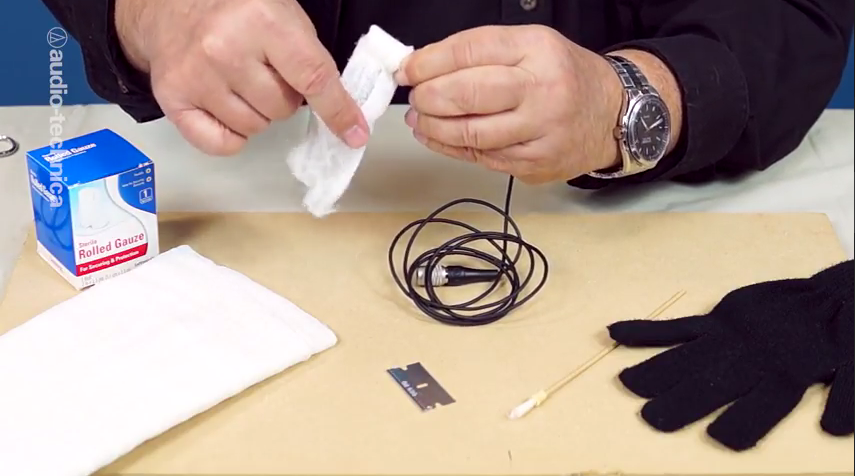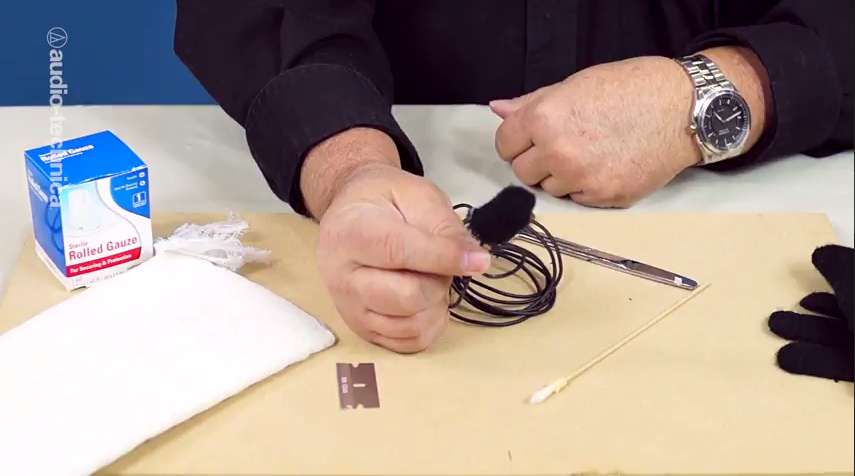This installment of our blog series on Basic Audio Techniques for Video explains how to avoid wind noise while recording outdoors. If you missed the previous installment discussing how to hide lavalier microphones, you can read it here.
If you are working indoors, wind noise is generally not a problem. You can hide the lavalier inside clothing to help shield the mic. However, when working outdoors, wind can be a real nuisance.
When wind blows directly into the open sound ports of a microphone, striking the diaphragm, it creates an irritating noise. The noise cannot be repaired during editing and must be completely cut out and replaced with another piece of audio. A strong gust of wind can easily ruin an otherwise good take, so here are some helpful do-it-yourself tips for making wind protection to use when recording with lavalier microphones.
 Most lavaliers come packaged with small, foam windscreens that you can slide over the body of the mic. Although you can use these when your mic is mounted on a tie bar mount outside of wardrobe, they are not a good choice if you need to rig your lavs inside of clothing.
Most lavaliers come packaged with small, foam windscreens that you can slide over the body of the mic. Although you can use these when your mic is mounted on a tie bar mount outside of wardrobe, they are not a good choice if you need to rig your lavs inside of clothing.
Windscreen for Light Wind
Moleskin or sticky triangles wrapped around a lavalier would most likely end up destroying that delicate piece of foam when the tape is removed, and constantly buying new windscreens can get expensive. However, you can make your own wind protection from the foam tips found on electronic cleaning swabs or even make-up swabs in just three simple steps.

 Step 1: Make sure that the tips are made of shaped foam, and not just wispy cotton.
Step 2: Pull the foam tip off of the wooden handle, and then use a sharp knife to slice off the tapered bottom.
Step 3: Remove the cotton stuffing if there is any.
There you have it! An easy to make expandable, foam windscreen that will only set you back a few cents if the tape ruins it.
Step 1: Make sure that the tips are made of shaped foam, and not just wispy cotton.
Step 2: Pull the foam tip off of the wooden handle, and then use a sharp knife to slice off the tapered bottom.
Step 3: Remove the cotton stuffing if there is any.
There you have it! An easy to make expandable, foam windscreen that will only set you back a few cents if the tape ruins it.

 Bonus Step: Don’t like the color? Just grab a Sharpie permanent marker or artist’s pen and color it as you see fit. Make certain that it’s a permanent marker and not a water-based color that might bleed if it gets moist.
When foam windscreens are marble shaped, they sometimes risk rubbing against clothing, even if mounted on a tie bar. These homemade windscreens, having a thinner profile, are less likely to make contact.
Bonus Step: Don’t like the color? Just grab a Sharpie permanent marker or artist’s pen and color it as you see fit. Make certain that it’s a permanent marker and not a water-based color that might bleed if it gets moist.
When foam windscreens are marble shaped, they sometimes risk rubbing against clothing, even if mounted on a tie bar. These homemade windscreens, having a thinner profile, are less likely to make contact.

Windscreens for Heavy Wind
On occasion, you may have to use a lavalier microphone to record outdoors during heavy wind conditions. Step 1: Begin with your foam swab windscreen. Step 2: Wrap a swaddling of porous cloth several times around the mic so that it begins to look like a Mummy’s thumb. Note: You can use cheesecloth, soft first-aid gauze, cut up T-shirts, or even gun cleaning patches. Step 3: To cap everything in place and provide an additional level of wind protection that is a bit more visually acceptable, snip off the fingertip of an inexpensive unlined knit glove.
Note: You can find unlined simple knit gloves at most stores. Look for children’s or small women’s sizes. And, in case you need to color coordinate, it is always a good idea to purchase a variety of colors.
Step 3: To cap everything in place and provide an additional level of wind protection that is a bit more visually acceptable, snip off the fingertip of an inexpensive unlined knit glove.
Note: You can find unlined simple knit gloves at most stores. Look for children’s or small women’s sizes. And, in case you need to color coordinate, it is always a good idea to purchase a variety of colors.
 This now gives you three effective layers against wind noise: foam, porous cloth, and knit outer shell. Essentially a zeppelin for your lavalier!
These easy tricks will keep the wind out of your audio every time.
This now gives you three effective layers against wind noise: foam, porous cloth, and knit outer shell. Essentially a zeppelin for your lavalier!
These easy tricks will keep the wind out of your audio every time.